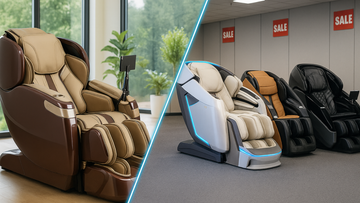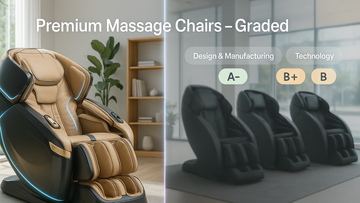Your shoulder blades (or scapula) are seated in your upper back. Their main job is to connect your collarbone or clavicle to your upper arms. Most of us often don’t realize how much we rely on our shoulder blades for countless tasks each day. When you cope with shoulder blade pain, even simple activities like opening a cabinet or putting on your shirt can seem challenging.
Performing shoulder blade stretches is one of the most efficient ways to relax the tension in your muscle and release the pain. Let’s decode what causes this pain, why stretches for shoulder blade pain can help boost recovery, and how to stretch your shoulder blade the right way.
What Causes Shoulder Blade Pain?
You’ll notice shoulder blade pain either at the onset or gradually after you’ve had an active day. The nagging pain that seems to seep under or around your shoulder blades can be caused due to several reasons. Fortunately, performing basic stretches for shoulder pain can make a massive difference. Here are some of the common causes of pain around your scapula.
- Tense Muscle or a Muscle Knot - the most common trigger for shoulder blade pain. Imagine pulling a loose thread hanging from a sweater. What do you notice? A hard knot appears in the fabric. Something similar takes place when you deal with a tense muscle under your scapula. The area feels tight or tender to the touch.
- Coping with an Injury - If an injury is involved, pain may travel and settle between your shoulder blades, even if the injury is in another part of the body.
- Other Triggers - may include acid reflux, nerve compression, scoliosis, narrowing of the spinal cord, spinal stenosis, osteoarthritis, myofascial pain syndrome, shingles, and more.
No matter what could be causing the shoulder blade pain, using stretching techniques and warming up before exercising can help reduce pain or discomfort. By warming up the muscles in your shoulders, you reduce the risk of strain or further injury. For recovery, check out some of the best stretches below.
How Shoulder Blade Stretches Can Help You Heal
Can shoulder blade stretches truly help, you ask? Think about it this way – when you stretch a muscle, its bands of connective tissue (the surrounding fascia and fibers) extend to full length. This brings several benefits to your “recovery table.” Some of them include:
-
An increase in mobility
-
Relief from pain
-
Posture improvement
-
Tension reduction
-
Lower risk of joint and muscle injury.
A study conducted in 2015 revealed how a 4-week regular stretching regimen could lower shoulder and neck pain among its participants. Although stretches for shoulder blade pain are a great way to relieve the pain, it’s best to consult with your doctor or physical therapist before you kick-start the process. You can also check out a great guide on how to relieve shoulder tension at home.
Try These Stretches for Shoulder Blade Pain Recovery
If you’re trying to decode the question, “How to stretch your shoulder blade,” here is your answer:
How to Warm Up Before Shoulder Blade Stretches
Warming up before taking a deep dive into shoulder stretches helps to keep your muscles limber - and good blood flow in your joints and around your shoulder muscles can help prevent injury.
Arm circles are the easiest way to get the blood flowing to the structures around the joints. These can be done pretty much anywhere and require no fancy equipment - just stand with your feet shoulder-width apart and form a “T” with your arms. Move them in a small circular motion for 10-15 seconds clockwise and then in a counterclockwise direction.
After completing 3-4 reps, you will be ready to get into some deeper shoulder blade stretches.
Shoulder Blade Squeeze
A shoulder blade squeeze is one of the most common types of shoulder blade stretches. You can perform this while sitting or standing. The steps include:
- Stand or sit up tall by keeping your arms on the side
- Relax your shoulders
- Squeeze those blades together
- Count to six, then relax
- Repeat 8-12 times
Cross-Body Shoulder Stretch
Cross-body shoulder stretch is another great answer to the question, “how to stretch shoulder blade knots.” The steps include:
- Stand tall and stretch your right arm straight
- Bring it across your body (in a way that your hand points toward the floor on the other side of your left leg)
- At the elbow, bend your left arm
- To support the right arm above the elbow, keep the left forearm hooked under the right arm.
- Try to pull the right arm further by using your left forearm
- Hold for 20 seconds and perform on the other side
Shoulder Roll
One of the most convenient shoulder blade pain stretches, the steps included in a shoulder roll stretch include:
- Stand tall, and tuck in your chin slightly.
- Relax your arms (remember, all movements must be in your shoulder blades)
- Move your shoulders up in the direction of your ear, go up and back.
- Circle your shoulders around to loosen them up.
- Repeat these circular movements at least 2 to 4 times.
Stretching with a Towel
This stretch extends your internal rotators to help you make overhead motions with ease. The steps include:
- Place a towel over your right shoulder
- Try to grasp it with your left hand by reaching it from behind your back.
- Once you hold the towel with your left hand, use your right hand to reach the top end of the towel.
- Gently pull the towel upward from the front side (right hand) of your body.
- Perform the stretch 3 times, then repeat it by placing the towel over your left shoulder.
- Discontinue the stretch if you feel any pain.
Doorway Stretch
The doorway stretch helps boost muscle flexibility in the pectoralis minor and pectoralis major regions of your shoulders. The steps include:
- Face the doorway, raise and bend your arms at a 90-degree angle (forming an “I”). Make sure your palms face forward.
- Rest your hands on both sides of the doorway and try to take a step forward. You’ll feel a gentle stretch in your chest.
- Feel this stretch for 30 seconds to one minute.
Does Using a Massage Gun After Shoulder Blade Stretches Help?
Massage guns boost blood circulation to relieve any stiffness or pain in your muscle. When the blood flow increases, your body begins to remove waste products and other metabolites (lactate, for instance) to kickstart muscle recovery. Massage guns may also relieve the Delayed onset of Muscle Soreness (DOMS).
To use a massage gun, make sure you sit or stand in a comfortable position. Keep the gun perpendicular (and steady) to target the pain areas. Begin with a low setting and slowly increase the intensity.
The Magic of Combining Massage & Shoulder Blade Stretches
Although shoulder blade stretches contribute to your healing process, they are typically not enough. Sometimes shoulder massage techniques come in handy on your road to recovery and for pain relief. What’s more, the pain you already face makes it difficult to continue with the stretches. A massage chair can be a great alternative to shoulder blade pain stretches. But how does the process work?
Once you cozy up in a massage chair, the heat targeted toward your problem area helps supply a fresh flow of blood to your muscles. This feeds them with oxygen-rich nutrients. Gradually, your body begins to see improved circulation and reduced blood pressure. (Want to learn more? Read our guide to the benefits of heat therapy.)
The technology works with the deeper layers of tissues in the region, extends muscle fibers, and releases trigger points. The result is an increase in the range of motion inside your shoulder joint. The chair also puts your muscles in a “relaxation mode” to ward off the tension and a welcome relief from pain.
If your shoulder pain results from a sports injury, the chair analyzes your requirements and deploys a sports massage therapy to correct any imbalances of soft tissues that may have resulted from repetitive motions. Finally, the chair helps stabilize your muscle, works on your posture, strengthens the rotator cuff, and improves the health of scapular muscles to lower the possibility of similar pains down the line.
The power of a luxury massage chair isn’t just limited to shoulders but extends to your full body. It not only offers pain relief for most physical pain, but a full body massage can reduce stress as well!





